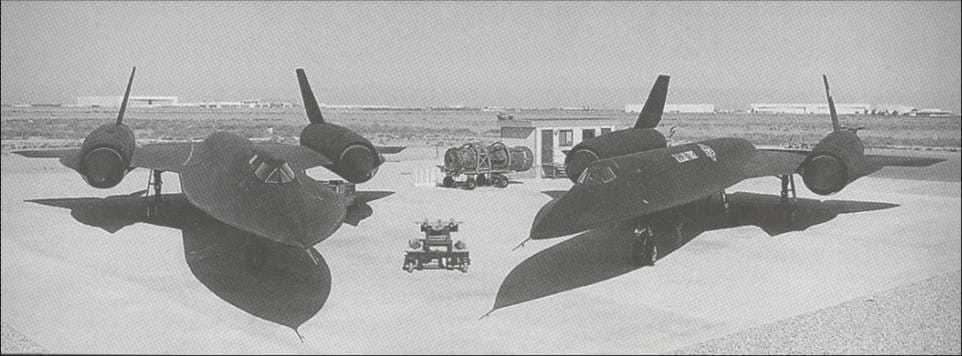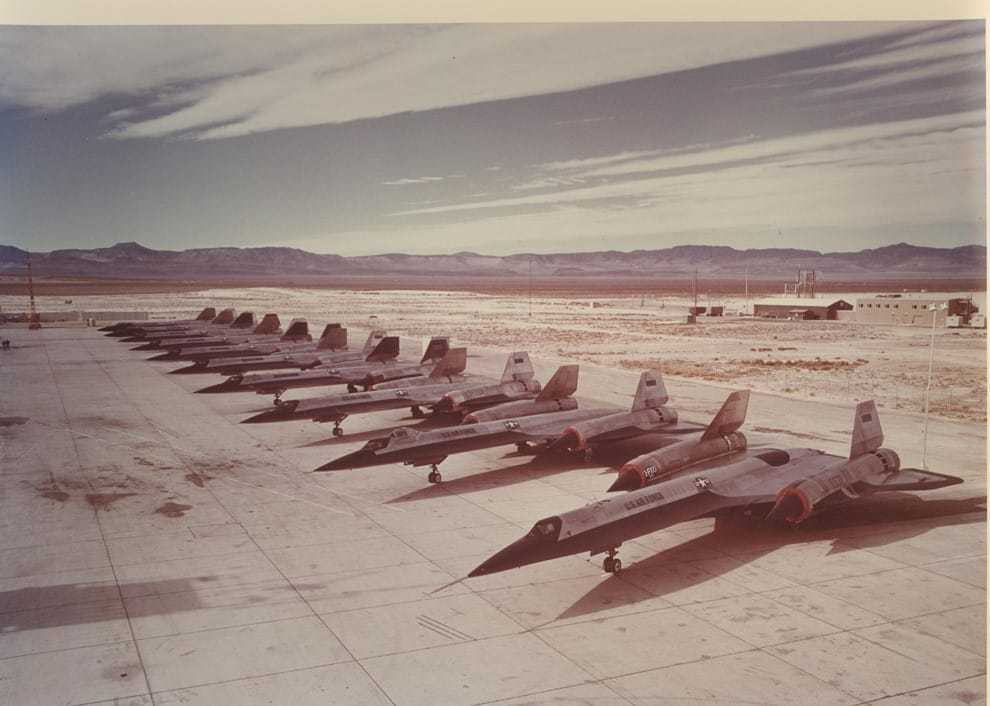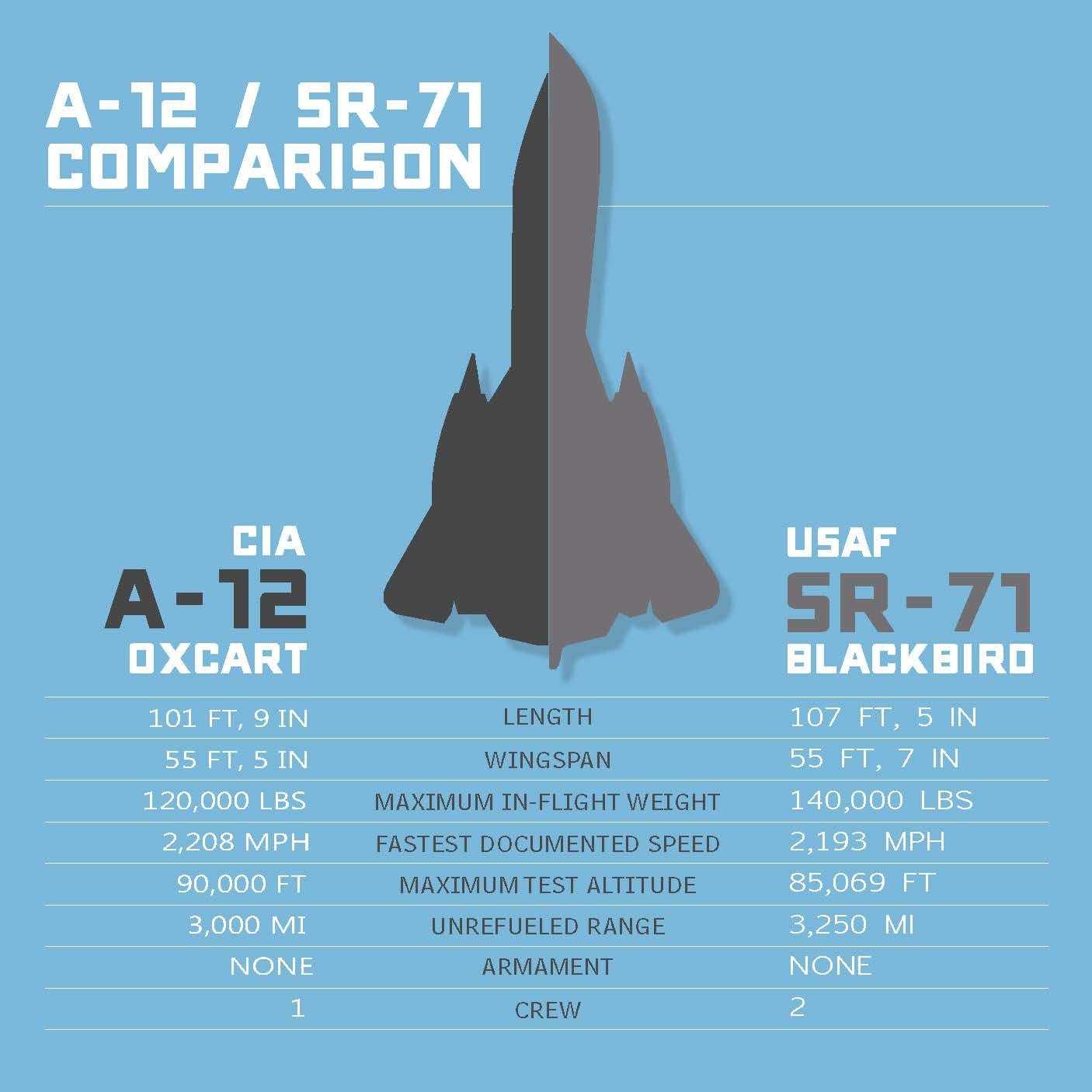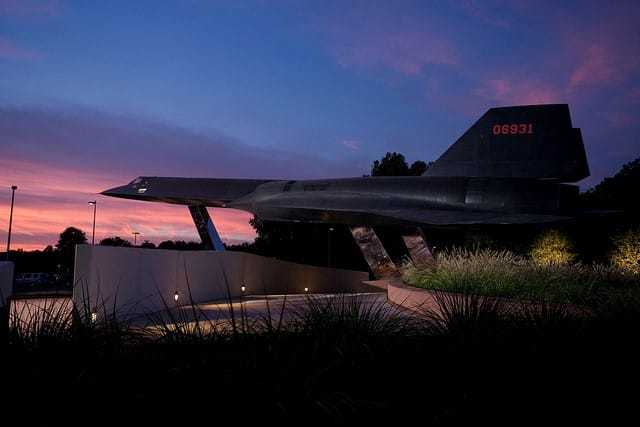
Can you tell the difference between the two aircraft pictured above? Most people can’t. Often confused with one another, CIA’s A-12 OXCART and the US Air Force’s SR-71 Blackbird are actually two different aircraft.
CIA developed the highly secret A-12 OXCART (above right) as the U-2 spy plane’s successor, intended to meet the nation’s need for a very fast, very high-flying reconnaissance aircraft that could avoid Soviet air defenses. It became operational on November 12, 1965.
Not only did the A-12 prove its worth during its short operational life, but the overall OXCART project produced the second-longest-lasting aerial reconnaissance platform in US intelligence history: the SR-71.
The SR-71 Blackbird (above left) was the Air Force’s two-seat follow-on version of the OXCART. In fact, the A-12 OXCART’s unique design and characteristics became the foundation for three other versions of supersonic aircraft that Lockheed built for CIA and the Air Force: the YF-12A, the M-21, and of course, the SR-71.
In the end, the OXCART’s engineering innovations produced the two fastest, highest-flying, piloted jet aircraft ever (the A-12 and SR-71) and pioneered stealth technology that would later be adapted for use in subsequent aircraft.
How It Began
Clarence Leonard “Kelly” Johnson, Lockheed’s aviation genius, is credited with creating the OXCART and Blackbird. He was a groundbreaking aeronautical engineer who worked for Lockheed Aircraft for over four decades.
Born in Ishpeming, Michigan, on 27 February 1910, he joined Lockheed in 1933, where his contributions to advanced aircraft design were extraordinary. Johnson designed or contributed significantly to the development of at least 40 well-known and important military and civilian aircraft, including the U-2, the A-12, and the SR-71.
In 1959, CIA awarded the OXCART contract to Lockheed, where Johnson’s team had to overcome several daunting technical challenges to create the new high speed, high altitude reconnaissance aircraft that was capable of avoiding interceptors and missiles.
The engineers used cutting-edge innovations in titanium fabrication, lubricants, jet engines, fuel, navigation, flight control, electronic countermeasures, radar stealthiness, and pilot life-support systems to meet these challenging requirements. The A-12 was America’s first stealth plane, though it was never completely stealth because the amount of fuel it had to carry to fly so fast for so long required changes in the design of the airframe that made it easier to track on radar. The innovative design and technologies developed for the A-12 were used for years after and helped lay the foundation for future stealth research.
In 1965, after hundreds of hours flown at high personal risk by an elite team of CIA and Lockheed test pilots, the A-12 was declared fully operational, attaining a sustained speed of Mach 3.2 (just over 2,200 miles per hour) at 90,000 feet altitude—an unbroken record for piloted jet aircraft.
OXCART’s First Mission
The only A-12 reconnaissance operation, codenamed BLACK SHIELD, took place from May 1967 to May 1968, initially over Southeast Asia and then North Korea. A detachment of six pilots and three A-12s based at Kadena Air Base in Okinawa, Japan flew 29 missions over East Asia.

Piloted by Mele Vojvodich, the first BLACK SHIELD flight took off in a torrential downpour just before 1100 local Okinawa time on May 31, 1967. The A-12 had never operated in heavy rain before, but weather over Vietnam was forecast as satisfactory, so the flight went ahead.
Vojvodich flew the planned route at 80,000 feet and Mach 3.1, refueled immediately after taking off and during each of two loops over Thailand, and safely touched down at Kadena with a total flight time of three hours and 39 minutes.
The intelligence mission was a resounding success: after detailed examination of nearly a mile of film that was collected, photo interpreters found no surface-to-surface missiles that might threaten US and allied military forces in the South and assessed the status of 70 of the 190 known surface-to-air missile sites and nine other priority targets.
Contrary to some published accounts, Chinese or North Vietnamese radar did not track the aircraft during the Vojvodich flight, nor did North Vietnam fire any missiles at it. On subsequent missions in October 1967 and January 1968, North Vietnam fired SAMs at BLACK SHIELD A-12s three times but caused damage only once.
OXCART Gives Way to Blackbird
In December 1962, the Air Force ordered six “reconnaissance/strike” or SR aircraft for high-speed, high-altitude flights over hostile territory: the SR-71 Blackbird.
The SR-71 got the name “Blackbird” because of the special black paint that covered the aircraft. Although the Blackbird’s stealthiness resulted from radar absorbent structures along the chines, wing edges, vertical tails, and inlet spikes, the paint helped to release some of the heat generated by air friction and to camouflage the aircraft against the dark sky at high altitudes.
As a modified version of the A-12 OXCART, the SR-71 Blackbird was about six feet longer, weighed an additional 15,000 pounds fully loaded, had a more prominent nose and body chines, had a two-seat cockpit, and carried additional optical and radar imagery systems.
After an initial contract for six Blackbirds, the Air Force ordered 25 more in August 1963. The first SR-71 flew on December 22, 1964. Throughout its operational career, the SR-71’s primary operation base was also out of Kadena Air Base in Japan, although other bases also hosted Blackbird operations, including Beale AFB in California, and RAF Mildenhall, England.
Retirement
Because the Air Force was developing the Blackbird, there was little value in maintaining both the overt SR-71 and covert A-12 fleets with similar capabilities. President Johnson ordered retirement of the A-12 OXCART by 1968.
By then, CORONA satellites were regularly launched to collect thousands of images worldwide each year, and although its imagery was less timely and of poorer resolution than that from the A-12 and SR-71, CORONA was safe from anti-aircraft missiles and much less provocative than aircraft overflights.
Besides, the A-12’s original mission to monitor the Soviet Bloc had been halted years prior, after the U-2 piloted by Francis Gary Powers was shot down over the Soviet Union in May 1960.
Although the A-12 was officially retired, the SR-71 continued to fly and remained a vital tool for intelligence gathering, providing information that was vital in formulating successful US foreign policy.
In the late 1980s, enthusiasm for the expensive SR-71 program waned as the performance of space-based systems grew, and in November 1989, the Air Force deactivated the Blackbird.
On January 21, the last SR-71 Blackbird left Kadena Air Base, and the SR-71 was decommissioned at Beale Air Force Base in California on January 26, 1990.
Then, in September 1994, Congress allocated funds to reactivate three SR-71s, and two aircraft became operational for a brief period during 1995 and 1996.
In October 1997, President Bill Clinton vetoed further funding, and in June 1999 the SR-71 program was officially terminated.
Which Is Faster?
Inevitably, any comparison of the two aircraft will lead to the question: which one is faster? There is lot of controversy among airplane enthusiasts as to which aircraft holds that title. There’s no simple answer.

The OXCART has a documented maximum speed and altitude of 2,208 MPH at 90,000 feet, set during a test in 1965, while the SR-71 holds the official speed record for a piloted operational jet aircraft of 2,193 MPH, set on July 28, 1976. On the same date the Blackbird set an official world altitude record of 85,069 feet.
Unofficially, of course, pilots of both aircraft have anecdotal stories indicating the numbers of both aircraft may be higher, and some SR-71 test reports show that the aircraft surpassed the official records for speed and altitude.
Nevertheless, both the A-12 OXCART and the SR-71 Blackbird are regarded as pioneering achievements in aeronautical engineering and the pinnacle of aviation technology during the Cold War.
OXCART Returns Home
In 2007, the US Air Force transferred one of the nine remaining A-12s to CIA for display, just in time for CIA’s 60th anniversary celebration. This A-12 was the first of the operational fleet to be certified to fly at Mach 3, and during its lifetime, it logged 453 hours on 232 test and training flights before its retirement on May 28, 1968.

The A-12 arrived at CIA Headquarters aboard five wide-load trucks, and it required two enormous cranes to lift the 39,000-pound airframe onto its three-pylon mount to be assembled in 10 days. The pylons hold the airframe in an operational flight attitude at 85,000-90,000 feet—its nose up 8 degrees and airframe rolled 9 degrees to the left. Engineering specifications insure that the airframe as mounted could withstand winds of up to 130 mph.
The site also commemorates two CIA A-12 pilots, Walt Ray and Jack Weeks, killed in 1967 and 1968, respectively. For the CIA workforce, the A-12 is a symbol of the successful collaboration of the Intelligence Community, the Defense Department, and private industry to create a national strategic asset that our adversaries never dreamed possible.

